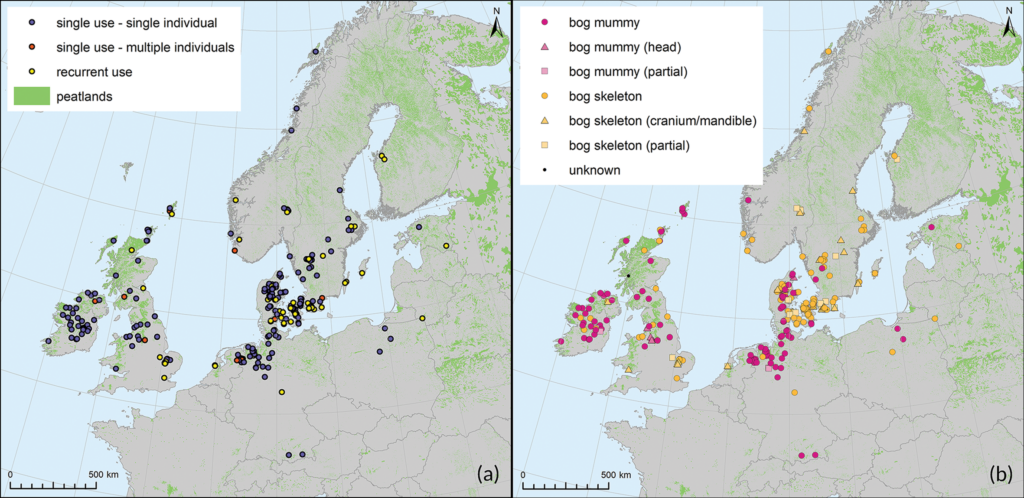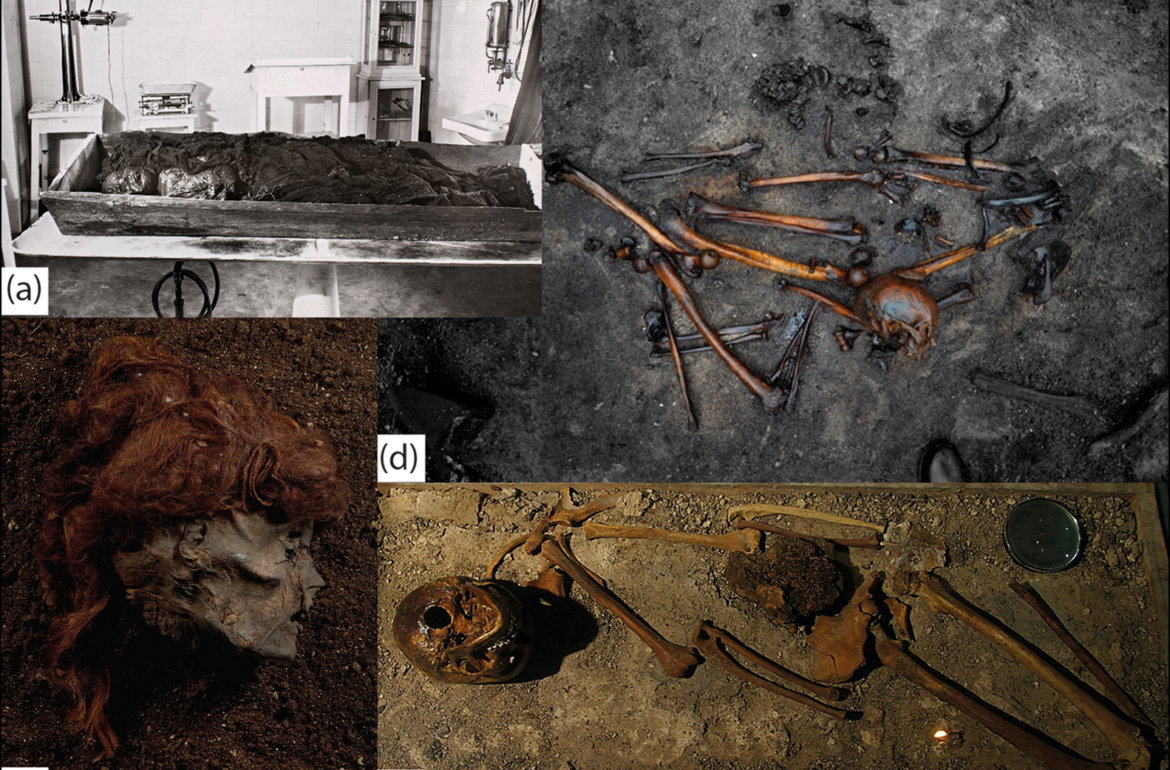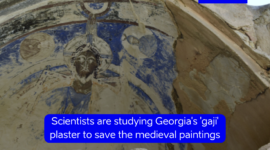Thousands of people have been laid to rest in Europe’s peat bogs over the millennia, whether through human sacrifices, slayings or more or less dignified burials. Studies of bog bodies usually focus on the individual biographies of several well-preserved mummies, but now a team of scientists has developed a bird ‘ s-eye overview of all northern European peat bog remains and discovered a previously unnoticed pattern of human sacrifice and violence.
“The goal of our research was to give a bigger picture. While individual bog body studies are fascinating, we must also look for broader shifts in people’s practices and worldviews,” Pikne Kama, co-author of the international study and an advisor of sacred natural sites at the Estonian National Heritage Board, explains.
In the research publication, the authors explain that the current knowledge of “the bog body phenomenon” is biased in two important respects:
- First, the distinction between bog mummies and bog skeletons is often misleading because it relates merely to preservation circumstances, not human past practices. Nevertheless, mummy research continues to dominate the debate, and as a result, too broad conclusions are drawn from a small sample, which is not representative.
- Second, most overviews cover narrow time periods and specific regions. So some parts of Europe (e.g. Norway, Finland, Poland and the Baltic states) and some time periods (especially the medieval and post-medieval) are rarely included in overviews.
So, the authors gave the first pan-European analysis of nearly all well-dated human remains from northern Europe and the British Isles mires (all types of peatlands included fens, coastal bogs, blanket bogs and raised bogs). The new database is based on 266 sites and more than 1,000 sets of human remains. “Of course, not all of these remains are well-preserved mummies. Some of them are skeletons or even partial skeletal remains,” Kama went on to explain the project.
The total estimated number of known bog bodies in Europe, including mummies and skeletons, is about 2000. Recent regional surveys are uncovering many more sites, and the number of skeletons and skeletal fragments now greatly outnumbers the number of mummies. Many more discoveries have been lost in the past or are only known through published sources; these are commonly referred to as “paper” bog bodies, and some of them are very well described.
The circumstances of preservation
With their low oxygen levels and antibacterial properties of Sphagnum moss, raised bogs help in full body mummification. But human tissue survival also depends on how quickly an individual was immersed in water, the temperature and time of year, and the presence of certain insects and microorganisms.
In more alkaline mires, often only bones will be preserved. Similarly, wool, skin and leather garments may be better kept than plant fibre clothing, such as linen. Even inside a single bog area, preservation conditions may vary greatly and these circumstances also change over time.
The researchers suggested that such variation in the environment and preservation levels of bog bodies means that earlier sharp classification between mummies and skeletons is not justified.
Moreover, human remains discovered in bogs were virtually always deposited there intentionally. “When it comes to the wild animals that live in the bogs, finding their remains is extremely rare. There are a few exceptions, but in general, the development of bog bodies requires some kind of human effort or practice. It is usually a specific human practice, such as ritual human sacrifice, but it could also be tied to a murder,” Kama went on to explain.
Geographical considerations
The majority of the study’s data comes from what are now Denmark, Ireland and northern Germany. In many of these locations, only the remains of a single individual were found in one bog area; however, sites with multiple individuals, typically two or four, have been identified as well, but these are extremely rare.
One notable exception is the Danish site of Alken Enge, which contains the remains of more than 380 people slain in violent conflict and dumped in open water. “Denmark has historically been significantly more densely populated, with more bog bodies discovered per unit of land than elsewhere,” the researcher explained.
There have been considerably fewer discoveries in Poland, Finland and the Baltic states. In particular, only two Estonian sites were considered in the final analysis. “Certainly, there are many more of them around here than the study suggests, as evidenced by numerous reports in folklore and the press, but unfortunately, little is known about these remains. So we don’t know if someone was buried there 50 years ago or, say, in the late Iron Age,” Kama explained.
Most of the discoveries have come to light during peat extraction and drainage work; however, much less peatland in the Baltic states has been drained and exploited than in Western Europe, which means there have been fewer opportunities to find bog remains here. As new findings will certainly emerge, it will be possible to amend the patterns and conclusions laid out in this analysis, Kama continued.
Unfortunately, the likelihood of discovering new peat bog bodies has diminished compared to the past. For example, even while peat exploitation flourished in Eastern Europe during the Soviet era, there was now a new challenge: “Since the 1960s and 1970s and the introduction of heavy machinery, there have been fewer scientific finds here, and we can see the same in western Europe,” Kama said. “Even if a body emerges from a bog during machine excavation, it is not as easy for a tractor or machine operator to notice it.”
The secrets of bog mummies
Cause of death is established for 57 individuals — and in 45 cases, violence was clearly involved. “Soft tissues are better preserved in peat bog burials than in cemeteries, which makes it easier to determine the cause of death as injuries and deformation marks, for example, may be clearly visible,” Kama said, adding, however, that according to their data in the majority of cases, the cause of death is unknown.
So when a cause could be identified, it was usually an act of violence, such as stabbings, head injuries, strangulation or hanging. The team suggests that even setting aside accidental deaths, the significant evidence for violent deaths (and the large number of repeatedly used mire sites) shows that most finds reflect intentional depositions.
Separating “ritualistic” from other types of violent activities, such as military confrontations, raids or robberies, is sometimes impossible based solely on archaeological data. The exceptions would be “cult sites,” where other things were ritually buried alongside human bodies. The same could be said of people who were subjected to excessive violence or “overkill,” which are generally classified also as ritualistic offerings.
According to the data, the bulk of the remains discovered in the bogs were men. “Some bog graves were formed as a result of military activities and are associated with warriors; for example, Denmark’s Alken Enge,” Kama explained. But while males form the largest group, certain periods show almost equal numbers of females and males. Children of various ages were found as well.
Making new overall chronological and spatial mapping
In general, human remains have been deposited in mires from the Mesolithic through contemporary periods, and the researchers noticed that the study of long-term trends is still lacking. As a result, they proposed dividing the bog bodies into six-time groups based on chronological peaks and spatial clustering.
The earliest period constitutes a cluster of skeletal remains from southern Sweden and Denmark, which dates to the fourth millennium BC. Then, there is a concentration of skeletons dating to the later second millennium BC in the area of modern-day Ireland and Britain. The Iron Age and Roman period are generally considered the peak of the “bog body phenomenon,” with finds distributed throughout north-west Europe. The earliest findings from Germany, Poland and the Baltic states date from 1000 BC to 1100 AD. And yet, the majority of the medieval and later finds mainly come from Scotland and Ireland.
According to the researchers, this new chronological and spatial mapping provides greater insight into how the practice of bog burial evolved over time and expanded geographically. For example, the Stone Age and the Middle Ages lived in the same environment, but their thoughts, habits, and beliefs radically differed. So, the later period shows both a marked intensification in the economic exploitation of mires and a simultaneous continuation of “pagan” practices, including “ritual” depositions, well into early modern times.
Why were human remains deposited in peat bogs?
The researchers have summarized these reasons into five categories:
- The remains of ritualistic sacrifice to supernatural powers, for example, for fertility or agricultural success;
- Burials of deceased (and sometimes executed) individuals who had transgressed social conventions and were not allowed burial in a usual way;
- Victims of criminal acts;
- “Deviant” burial customs;
- Accidental deaths in treacherous circumstances, e.g. drowning.
Detailed comparative studies of spatial and temporal trends concerning these causes are still lacking. “Even bog bodies from the same period may be linked to different traditions,” Kama said. “And is the late 16th-century Rabivere bog mummy discovered in Estonia comparable to the bog mummy discovered in Ireland during the same time period, could there be some similarity in their origins?” these are still open questions.

A unique source of information
Kama went on to say that the findings do provide valuable information about the way of life of the people of the period. “In the case of mummified bodies, it is sometimes even possible to determine the time of the last meal these people had, and we can see their hairstyles and clothes in detail. It certainly provides information that we don’t otherwise have access to, or have very little, from traditional burials,” he said.
In sum, the team identified regional and chronological trends in the deposition of human remains in European mires using data from over 1000 individuals. They showed that well-preserved bog mummies, which have been key to scientific arguments so far, represent merely one end of a puzzle. Fully mummified remains are often more recent in date and are only found in certain sections of northern Europe, while the more inclusive technique enables the detection of previously overlooked overall trends.
Moreover, the project revealed that there is strong evidence for violent causes of death, and in certain cases, such findings have a clear “ritual” nature. The researchers also point out that accidental deaths and potential suicides may have been more common than was previously believed.
The sheer scope of the investigation and new technologies helped the scientists build a new, detailed database that includes all finds of human remains from mires throughout northern Europe. (South-central Europe and the Mediterranean are excluded, as they have very few mires).
So, if you come across an older-looking corpse in a bog, notify both the heritage agency and the police. The context and exact location of the human remains are the most crucial factors of archaeological discovery; without professional assistance, these are easily lost.
The study was published in Antiquity.
* Authors: Roy van Beek, Cindy Quik, Sophie Bergerbrant, Floor Huisman and Pikne Kama
Written by Jaan-Juhan Oidermaa, Kristina Kersa. This article was originally published on the Estonian Public Broadcasting webpage.
 Back
Back



